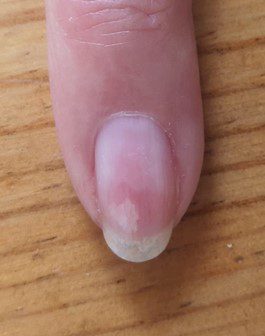nail plate band
We see it every day at work, but do we really know what it is? To understand better, let’s take a closer look at Doug Schoon’s diagram.
If you try to look from behind the free edge, you’ll see something like this:

• The nail plate zone is a non-living tissue. It is an extension of the floor epithelium.
-It is a grayish brownish color.
Onychodermal band: Hidden protective barrier
Between the nail plate and the nail bed there is a bed epithelium. When the bed epithelium reaches the edge of the nail bed and folds back, it becomes the nail plate band. This narrow, compacted tissue serves as a special pathogenic barrier under the free edge of the nail plate. It forms a partnership with Hyponycium and together they become a super seal. It often goes unnoticed and is almost invisible. You have to look carefully to recognize it.
The onychodermal band is a slightly translucent, thin layer beneath the distal (free edge) edge of the nail plate, extending across the width of the nail plate and contiguous with the visible white of the free edge.
Onychodermal bands prevent the smallest infectious microorganisms and contaminants from entering the nail bed. When this protective tissue (pathogenic barrier) is breached, the nail plate separates from the nail bed, causing onycholysis, which dramatically increases the risk of infection.
Its partner in the nail unit is the hyponycium, which is one of the four protective seals in the nail unit and is designed to protect the nail bed from bacteria and other infections such as fungi and yeast. . Hyponycium, on the other hand, is composed of living epidermal tissue. It is important to note that onychodermal bands are non-living tissue and must remain elastic to function effectively.
Strengthening elasticity: Apply oil behind the free edge for nail health
Applying oil behind the free edge and not above the nail plate will help maintain the necessary elasticity, even if the nail plate band has already peeled off.
Precautionary measures and autoimmune considerations in nail care
If you use an efile to shorten the nail that comes out of the nail reinforcement behind the free end, or if you use a sharp instrument to clean under the free end, there is a risk of accidentally damaging the nail Be aware that the results can quickly manifest as onycholysis.
Some autoimmune diseases can also have an impact.
• Psoriasis
• Lichen planus
• Eczema
These are all diseases that can affect the nail plate, nail matrix, nail plate, or nail bed and cause breakdown of the seal. It is very important to apply oil behind the free edge. This is because the oil repels water, keeps the Guardian Seal elastic, provides no food source for bacteria, and provides excellent protection.
In this image you can clearly see how psoriasis affects you. When an “oil slick” blister forms, the epithelium of the blister is directly affected by the upward pressure of the blister, causing it to separate from the nail bed. It is true that onycholysis occurs when the nail plate moves (perpetual motion) and the damaged bed epithelium approaches the free edge, exposing the nail bed to all pathogens.

In some cases, you may notice that the hyponychium is pulled together with the nail band. Simple factors such as product shrinkage (but not always noticed) can easily cause this problem. If you notice this happening, stop using nail products until the hyponycium has healed, or find a more flexible product. Good quality oil is your friend here too. Working with cuticle pushers or electronic files in this area can cause further irritation.
The onychodermal band is of paramount importance to the overall health of the nail, so it must be handled with care. Be careful when cleaning under the free edge. To keep the nail unit healthy, it is recommended to always avoid placing sharp objects under the free edge and clean it with a soft brush and oil.
The conclusion is
Onychodermal bands may go unnoticed in our daily lives, but they play an important role in protecting nails from infection and maintaining overall nail health. Understanding their function and how to care for them is essential to the health and hygiene of your nails. So, the next time you get your nails done, remember the importance of onychodermal bands and treat them with proper care to keep your nails looking and feeling their best.


